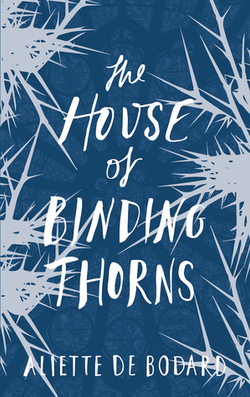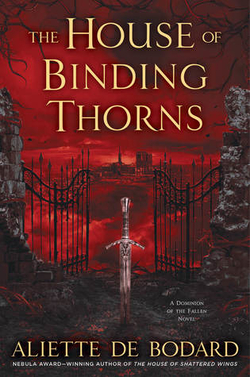The second Dominion of the Fallen novel sees Aliette de Bodard return to the city of down-on-their-luck divinities she depicted so delicately in The House of Shattered Wings in the company of a cast of characters that were in the background of book one. In that sense it’s a sequel, however The House of Binding Thorns stands as a striking example of a story that both stands alone and expands.
Welcome, then—or welcome back, perhaps—to the capital of France after the collapse. Some sixty years on from “the cataclysm that had devastated Paris, reducing monuments to blackened rubble, turning the Seine dark with the dangerous residues of spells, and leaving booby traps that still hadn’t vanished,” the angels who fell from heaven on that dark day have organised themselves into powerful houses, very much in the mode of the mafia. Indeed, de Bodard doubles down on that extended metaphor in The House of Binding Thorns, in that its narrative is driven by drug trafficking and an addict on the road to recovery is its principle perspective.
But the drug doing the damage in postwar Paris is no conventional concoction of chemicals. It is, instead, angel essence: the magic-amplifying fiber of the Fallen. It is “the promise of pleasure, of power,” and power is what every mob boss wants, what every mob boss will do anything to get…
Asmodeus is just such a soul, as the head of House Hawthorn: a “brash statement of power” beside the “genteel, quiet, decaying thing” that is House Silverspires. “Silverspires had been Hawthorn’s enemy,” had kept it in check, “but the events of seven months ago”—so cannily chronicled in The House of Shattered Wings—”had left them bloodless and in ruins, barely capable of being a power in postwar Paris, much less a threat.”
With Hawthorn high on its triumph, every other House is battening down the hatches. But though the ex-angel Asmodeus’ organisation appears unequaled, in reality, it too is a ruin. “The House might look grand and magnificent, but it was like the rest of the city: barely hanging on to normality, struggling to maintain itself against decay.” Mold and char and rot are rife in the Dominion of the Fallen novels, giving the series a certain sickening stench, as of something spoiled. That said, there are also heady hints of what was: a beautiful world, all orange blossom and eau de bergamot.
And as above, so below. Literally, in this instance, for under the River Seine, another kingdom cometh. “Legends had come to life in this city, in this place. Tales that had always been distant dreams,” of angels, magic—and now dragons, or rather Rong.
 The Rong have lived in the Seine for centuries, little interested in the puny affairs of humans, but now they face a pair of problems that have led them to look for outside assistance: an epidemic of angel essence addiction and a rising tide of rebellious sentiment. And when you have to hire help, best to get the best—thus the Rong have reached out to Hawthorn. “No one in the kingdom really liked the idea of the alliance, or trusted Hawthorn to respect it, but there wasn’t much choice. They were too hard-pressed.”
The Rong have lived in the Seine for centuries, little interested in the puny affairs of humans, but now they face a pair of problems that have led them to look for outside assistance: an epidemic of angel essence addiction and a rising tide of rebellious sentiment. And when you have to hire help, best to get the best—thus the Rong have reached out to Hawthorn. “No one in the kingdom really liked the idea of the alliance, or trusted Hawthorn to respect it, but there wasn’t much choice. They were too hard-pressed.”
Asmodeus’ answer is to dispatch, among others, the alchemist and ex-addict Madeleine to talk terms, as well as investigate the fate of the last delegate Hawthorn sent under the Seine. Having “spent twenty years cloistered in her laboratory, putting together artifacts and drugging herself on angel essence, waiting for the death she’d been running away from to claim her,” Madeleine has a chance to redeem herself here, in Asmodeus’ eyes and her own—but only if she can keep clean.
Thuan’s perspective is in a sense the inverse of Madeleine’s chapters. He’s a dragon spy embedded in Hawthorn, working to uncover any connections that House has to the prevalence of angel essence in his heretofore hidden kingdom. The House of Binding Thorns also treats us to some time with Philippe, a Silverspires survivor working now as a doctor of sorts, determined to resurrect his late lover—this series’ last central character:
He wanted no part of House politics. He wanted no Fallen magic. And, above all, he wanted to stay away from Hawthorn and Asmodeus. But in the end, he owed Isabelle something he could never return, and all his unbending principles had ever brought was death.
Middle volumes like this—novels that are neither beginnings nor endings—are so often a mess of narrative half-measures, static settings and incomplete character arcs that they’ve become a bit of a bug-bear of mine. There’s a balance to be struck, I believe, between the busywork of preparing your pieces for play, and the telling of a tale worth telling. I dare say it’s a delicate balance; a knife edge, if you’ll permit me to pilfer that old image: sharp enough to slice and so narrow that many authors fall off in the process of picking their way across. Happily, de Bodard does so with complete confidence.
Rather than distracting readers with dramatic shenanigans before roundly restoring the status quo, The House of Binding Thorns incrementally advances the series’ larger narrative at the same time as relating a perfectly satisfying and self-contained story about one House’s attempts to defend against the devils at the door. Similarly, though several previous players reappear, their development doesn’t seem stunted, in no small part because de Bodard’s foremost focus is on a few new faces, each of whom she has such leeway with that they can be fundamentally affected by events. The Dominion of the Fallen’s almost anthological approach also allows the author to upsize an already impressive setting, leading to a world that feels leaps and bounds bigger than before, but no less essential.
That said, “there’s nothing here that will ever shake the foundations of the world. Nothing large or earth-shattering. But nothing here shallow, or meaningless, either,” so although The House of Binding Thorns isn’t, in the main, as engrossing as The House of Shattered Wings was, it is truly beautifully balanced: between new and old, birth and death, beauty and ugliness, inside and outside, beginning and, yes, ending. It walks the line, and walks it fine.
The House of Binding Thorns is available from Ace in the US and publishes with Gollancz in the UK.
Niall Alexander is an extra-curricular English teacher who reads and writes about all things weird and wonderful for The Speculative Scotsman, Strange Horizons, and Tor.com. He lives with about a bazillion books, his better half and a certain sleekit wee beastie in the central belt of bonnie Scotland.










